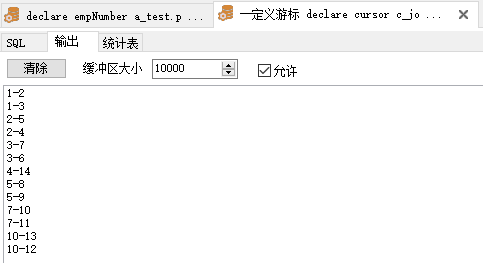1. 分类
常见的游标可分为显示游标、隐式游标、静态游标和动态游标四大类:
1.1 显示游标
显式是相对与隐式cursor而言的,就是有一个明确的声明的cursor。显式游标的声明类似如下:
delcare 游标关键字cursor 游标名 is 数据集;
游标从declare、open、fetch、close是一个完整的生命旅程。当然了一个这样的游标是可以被多次open进行使用的,显式cursor是静态cursor,她的作用域是全局的,但也必须明白,静态cursor也只有pl/sql代码才可以使用她。下面看一个简单的静态显式cursor的示例:

1 declare 2 cursor get_subid(pid a_test.parentid%type) is 3 select subid from a_test where parentid = pid; 4 v_subid a_test.subid%type; 5 begin 6 open get_subid(1); 7 loop 8 fetch get_subid 9 into v_subid; 10 exit when get_subid%notfound; 11 dbms_output.put_line(v_subid); 12 end loop; 13 close get_subid; 14 dbms_output.put_line('--------这是分割线----------'); 15 open get_subid(4); 16 loop 17 fetch get_subid 18 into v_subid; 19 exit when get_subid%notfound; 20 dbms_output.put_line(v_subid); 21 end loop; 22 close get_subid; 23 end;

1.2 隐式游标
隐式cursor当然是相对于显式而言的,就是没有明确的cursor的declare。在Oracle的PL/SQL中,所有的DML操作都被Oracle内部解析为一个cursor名为SQL的隐式游标,只是对我们透明罢了。

begin for rec in (select user, sysdate from dual) loop dbms_output.put_line(rec.user || ':' || to_char(rec.sysdate, 'yyyy-mm-dd hh24:mi:ss')); end loop; end;
1.3 静态游标
静态游标是相对于动态游标而言的,普通显示定义的游标都是静态游标。
1.4 动态游标
动态游标是相对于静态游标而言的,要等到运行时才知道结果集查询语句是什么样的。

1 declare 2 type atest_rec is record( 3 pid a_test.parentid%type, 4 subid a_test.subid%type); 5 6 type app_ref_cur_type is ref cursor return atest_rec; 7 my_cur app_ref_cur_type; 8 my_rec atest_rec; 9 begin 10 11 if (to_char(sysdate, 'dd') = 30) then 12 open my_cur for 13 select parentid, subid from a_test where parentid = 1; 14 else 15 open my_cur for 16 select parentid, subid from a_test where parentid = 2; 17 end if; 18 19 fetch my_cur 20 into my_rec; 21 while my_cur%found loop 22 --当前不是30号 执行else 结果: 23 --2#4 24 --2#5 25 dbms_output.put_line(my_rec.pid || '#' || my_rec.subid); 26 fetch my_cur 27 into my_rec; 28 end loop; 29 close my_cur; 30 31 end;
【注】Record为记录数据类型。它类似于C语言中的结构数据类型(STRUCTURE),PL/SQL提供了将几个相关的、分离的、基本数据类型的变量组成一个整体的方法,即RECORD复合数据类型。在使用记录数据类型变量时,需要在声明部分先定义记录的组成、记录的变量,然后在执行部分引用该记录变量本身或其中的成员。
定义记录数据类型的语法如下:
1 TYPE RECORD_NAME IS RECORD( 2 V1 DATA_TYPE1 [NOT NULL][:=DEFAULT_VALUE], 3 V2 DATA_TYPE2 [NOT NULL][:=DEFAULT_VALUE], 4 VN DATA_TYPEN [NOT NULL][:=DEFAULT_VALUE]);
由上面的例子,可知cursor与REF cursor大致有以下几点区别:
1)PL/SQL静态游标不能返回到客户端,只有PL/SQL才能利用它。动态游标能够被返回到客户端,这就是从Oracle的存储过程返回结果集的方式。
2)PL/SQL静态游标可以是全局的,而动态游标则不是,不能在包说明或包体中的过程或函数之外定义动态游标。
3)动态游标可以从子例程传递到子例程,而普通游标则不能。如果要共享静态光标,必须在包说明或包体中把它定义为全局光标。 因为使用全局变量通常不是一种很好的编码习惯,因此可以用动态游标来共享PL/SQL中的游标,无需混合使用全局变量。
4)静态光标比动态游标标效率要高,所以在使用游标时首先考虑使用静态游标,也有人建议尽量使用隐式游标,避免编写附加的游标控制代码(声明,打开,获取,关闭),也不需要声明变量来保存从游标中获取的数据。这个就因人因事而定吧。
另外,在oracle9i以后系统定义的一个refcursor, 这是一个弱类型的游标,相当于.Net中用户var声明的变量,主要用在过程中返回结果集。

1 --创建存储过程 2 create or replace procedure sp_get_subid(pid ina_test.parentid%type, 3 out_subid out SYS_REFCURSOR) as 4 begin 5 open out_subid for 6 SELECT * FROM a_test WHERE parentid = pid; 7 EXCEPTION 8 WHEN OTHERS THEN 9 RAISE_APPLICATION_ERROR(-20101, 'Error in sp_get_subid' || SQLCODE); 10 end sp_get_subid; 11 12 --调用存储过程 13 declare 14 v_rent_rows SYS_REFCURSOR; 15 v_rent_row a_test%rowType; 16 begin 17 sp_get_subid(1, v_rent_rows); 18 Dbms_output.put_line('parentid subid'); 19 loop 20 fetch v _rows 21 into v _row; 22 exit when v _rows%NOTFOUND; 23 Dbms_output.put_line(v _row.parentid || ' ' || v _row.subid); 24 end loop; 25 close v_rows; 26 end;

2. 属性
2.1 说明
1 %FOUND: bool - TRUE if >1 row returned 2 %NOTFOUND:bool - TRUE if 0 rows returned 3 %ISOPEN: bool - TRUE if cursor still open 4 %ROWCOUNT:int - number of rows affected by last SQL statement
【注】NO_DATA_FOUND和%NOTFOUND的用法是有区别的,小结如下:
1)SELECT . . . INTO 语句触发 NO_DATA_FOUND;
2)当一个显式游标的 where 子句未找到时触发 %NOTFOUND;
3)当UPDATE或DELETE 语句的where 子句未找到时触发 SQL%NOTFOUND;
4)在游标的提取(Fetch)循环中要用 %NOTFOUND 或%FOUND 来确定循环的退出条件,不要用NO_DATA_FOUND
2.2 示例
2.2.1 示例一:

1 begin 2 3 update A_TEST set SUBID = '15' WHERE PARENTID = 4; 4 5 --SQL%ISOPEN是一个布尔值,如果游标打开,则为TRUE,如果游标关闭,则为FALSE. 6 7 if sql%isopen then 8 9 dbms_output.put_line('Openging'); 10 11 else 12 13 dbms_output.put_line('closing'); --对于隐式游标而言SQL%ISOPEN总是FALSE,这是因为隐式游标在DML语句执行时打开,结束时就立即关闭。 14 15 end if; 16 17 if sql%found then 18 19 dbms_output.put_line('游标指向了有效行'); --判断游标是否指向有效行 20 21 else 22 23 dbms_output.put_line('Sorry'); 24 25 end if; 26 27 if sql%notfound then 28 29 dbms_output.put_line('Also Sorry'); 30 31 else 32 33 dbms_output.put_line('Haha'); 34 35 end if; 36 37 dbms_output.put_line(sql%rowcount); 38 39 exception 40 41 when no_data_found then 42 43 dbms_output.put_line('Sorry No data'); 44 45 when too_many_rows then 46 47 dbms_output.put_line('Too Many rows'); 48 49 end;

【注】SQL语言分为DDL(Data Definition Language,数据定义语言,用来维护数据对象)和DML(Data Manipulation Language,数据操作语言,用于增删改表中数据,DML是伴随TCL事务控制的)。
2.2.2 示例二:

1 declare 2 3 empNumber a_test.parentid%TYPE; 4 5 empName a_test.subid%TYPE; 6 7 begin 8 9 if sql%isopen then 10 11 dbms_output.put_line('Cursor is opinging'); 12 13 else 14 15 dbms_output.put_line('Cursor is Close'); 16 17 end if; 18 19 if sql%notfound then 20 21 dbms_output.put_line('No Value'); 22 23 else 24 25 dbms_output.put_line(empNumber); --没有赋值,输出为空白 26 27 end if; 28 29 dbms_output.put_line(sql%rowcount); --没有记录,输出为空白 30 31 dbms_output.put_line('-------------'); 32 33 34 35 select parentid, subid into empNumber, empName from a_test where parentid = 4; 36 37 dbms_output.put_line(sql%rowcount); 38 39 40 41 if sql%isopen then 42 43 dbms_output.put_line('Cursor is opinging'); 44 45 else 46 47 dbms_output.put_line('Cursor is Closing'); 48 49 end if; 50 51 if sql%notfound then 52 53 dbms_output.put_line('No Value'); 54 55 else 56 57 dbms_output.put_line(empNumber); 58 59 end if; 60 61 exception 62 63 when no_data_found then 64 65 dbms_output.put_line('No Value'); 66 67 when too_many_rows then 68 69 dbms_output.put_line('too many rows'); 70 71 end;

【注】%Type是Oracle提供的一种数据定义方法,为的是使一个新定义的变量与另一个已经定义了的变量(通常是表的某一列)的数据类型保持一致,当被参照的那个变量的数据类型发生改变时,那么这个新定义的变量的数据类型也会随之发生改变。当不能确切的知道那个变量的类型是,就采用这种方法来定义变量的数据类型。
3. 操作
3.1 For循环游标
1 --声明游标:delcare 游标关键字cursor 游标名 is 数据集; 2 3 declare 4 5 cursorc_list is 6 7 selectp.fid, max(t.exp) exp 8 9 from view_pilot p 10 11 left join IO_FMS_BILLOFHEALTH t 12 13 ont.phr = p.fjobnumber 14 15 group by p.fid; 16 17 18 --For循环,类似.Net中的foreach方法: 19 20 --begin 21 22 --for 元素名 in 游标名 循环关键字loop 23 24 --执行语句; 25 26 --endloop; 27 28 begin 29 30 for c_row in c_list loop 31 32 update alarm_pilotintelligence 33 34 set C = GetAlarmStateByExp(c_row.exp) 35 36 where isprimary = 0 37 38 and pid = c_row.fid; 39 40 end loop;
3.2 Fetch游标
1 --定义游标 2 3 declare 4 5 cursor c_job is 6 7 select * from a_test order by parentid; 8 9 --定义一个游标变量 10 11 c_row c_job%rowtype; 12 13 begin 14 15 --使用的时候必须要明确的打开游标 16 17 Open c_job; 18 19 --开始循环标记 20 21 loop 22 23 --提取一行数据到c_row,相当ADO.Net中的SqlDataReader.Read()方法 24 25 fetch c_job into c_row; 26 27 --判读是否提取到值,没取到值就退出 28 29 --取到值c_job%notfound 是false 30 31 --取不到值c_job%notfound 是true 32 33 exit when c_job%notfound; 34 35 dbms_output.put_line(c_row.parentid || '-' || c_row.subid); --用于输出,这是oracle中最基础的方法之一 36 37 --结束循环,并关闭游标 38 39 end loop; 40 41 close c_job; 42 43 end;

【注】如果一个表有较多的列,使用%ROWTYPE来定义一个表示表中一行记录的变量,比分别使用%TYPE来定义表示表中各个列的变量要简洁得多,并且不容易遗漏、出错。这样会增加程序的可维护性。当不能确切地知道被参照的那个表的结构及其数据类型时,可以采用这种方法定义变量的数据类型。
3.3 While循环游标
上面【示例二】中的结果还可以通过While循环与Fetch相结合来实现:
1 --定义游标 2 3 declare 4 5 cursor c_job is 6 7 select * from a_test order by parentid; 8 9 --定义一个游标变量 10 11 c_row c_job%rowtype; 12 13 begin 14 15 --使用的时候必须要明确的打开游标 16 17 Open c_job; 18 19 --开始循环标记 20 21 --提取一行数据到c_row,相当ADO.Net中的SqlDataReader.Read()方法 22 23 fetch c_job 24 25 into c_row; 26 27 --while循环 28 29 while c_job%found loop 30 31 dbms_output.put_line(c_row.parentid || '-' || c_row.subid); 32 33 fetch c_job 34 35 into c_row; 36 37 --结束循环,并关闭游标 38 39 end loop; 40 41 close c_job; 42 43 end;
参考资料:
